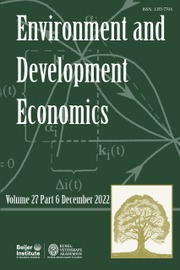Crossref Citations
This article has been cited by the following publications. This list is generated based on data provided by
Crossref.
King-Okumu, Caroline
2018.
Valuing Environmental Benefit Streams in the Dryland Ecosystems of Sub-Saharan Africa.
Land,
Vol. 7,
Issue. 4,
p.
142.
Mendes, Ângelo J.
Haydon, Daniel T.
McIntosh, Emma
Hanley, Nick
and
Halliday, Jo E. B.
2020.
Socially vs. Privately Optimal Control of Livestock Diseases: A Case for Integration of Epidemiology and Economics.
Frontiers in Veterinary Science,
Vol. 7,
Issue. ,
Paudel, Uttam
Adhikari, Shiva Raj
and
Pant, Krishna Prasad
2020.
Economics of environmental effects on health: A methodological review based on epidemiological information.
Environmental and Sustainability Indicators,
Vol. 5,
Issue. ,
p.
100020.
Loosli, Kathrin
Davis, Alicia
Muwonge, Adrian
Lembo, Tiziana
and
Selvapandiyan, Angamuthu
2021.
Addressing antimicrobial resistance by improving access and quality of care—A review of the literature from East Africa.
PLOS Neglected Tropical Diseases,
Vol. 15,
Issue. 7,
p.
e0009529.
Egeru, Anthony
Bbosa, Martha Mwesiga
Siya, Aggrey
Asiimwe, Robert
and
Mugume, Isaac
2022.
Micro-level analysis of climate-smart agriculture adoption and effect on household food security in semi-arid Nakasongola District in Uganda.
Environmental Research: Climate,
Vol. 1,
Issue. 2,
p.
025003.
Ahmed, Haseeb
Yoder, Jonathan
de Glanville, William
Davis, Alicia
Kibona, Tito J.
and
Cleaveland, Sarah
2022.
Relationships between vaccinations, herd introductions, and livestock losses in Northern Tanzania.
Agricultural and Resource Economics Review,
Vol. 51,
Issue. 1,
p.
1.
Kerfua, Susan Diana
Railey, Ashley Flynn
and
Marsh, Thomas Lloyd
2023.
Household production and consumption impacts of foot and mouth disease at the Uganda-Tanzania border.
Frontiers in Veterinary Science,
Vol. 10,
Issue. ,
Nthambi, Mary
Lembo, Tiziana
Davis, Alicia
Nasuwa, Fortunata
Mmbaga, Blandina Theophil
Matthews, Louise
and
Hanley, Nick
2023.
Quantifying farmers’ preferences for antimicrobial use for livestock diseases in northern Tanzania.
Q Open,
Vol. 3,
Issue. 1,
Emsley, Emily
Matshotshi, Asiashu
Mathebula, Eric
Mohlakoana, Setjhaba
Ramatla, Tsepo
Thekisoe, Oriel
and
Tsotetsi-Khambule, Ana
2023.
Assessment of gastrointestinal nematode anthelmintic resistance and acaricidal efficacy of fluazuron-flumethrin on sheep and goat ticks in the North West province of South Africa.
Veterinary World,
p.
1615.
Ahmed, Musa Hasen
and
Tesfaye, Wondimagegn Mesfin
2024.
Improved livestock production system and welfare in rural Ethiopia.
Review of Development Economics,
Loosli, Kathrin
Nasuwa, Fortunata
Melubo, Matayo
Mnzava, Kunda
Matthews, Louise
Mshana, Stephen E.
Mmbaga, Blandina T.
Muwonge, Adrian
Davis, Alicia
and
Lembo, Tiziana
2024.
Exploring drivers of self-treatment with antibiotics in three agricultural communities of northern Tanzania.
Antimicrobial Resistance & Infection Control,
Vol. 13,
Issue. 1,


